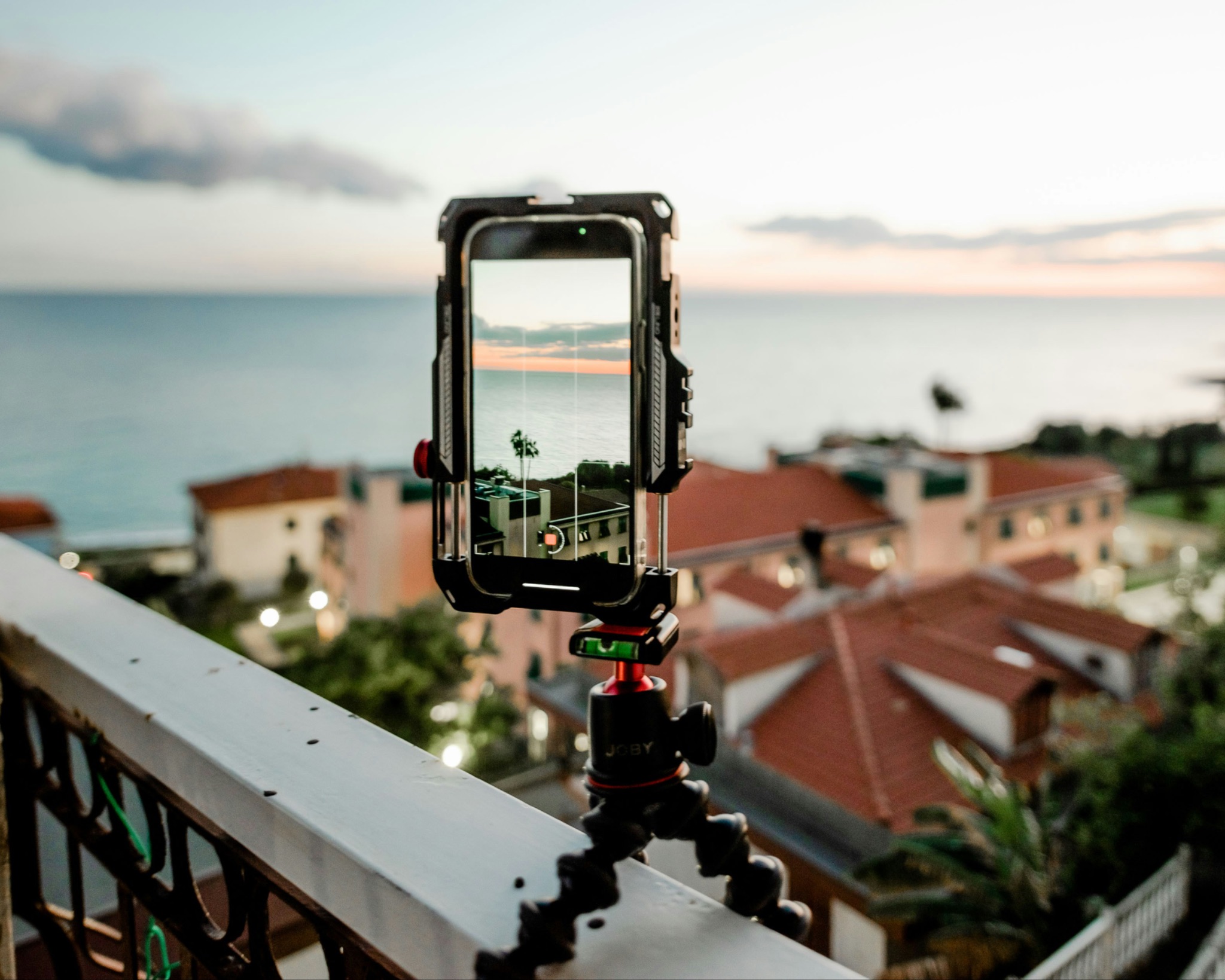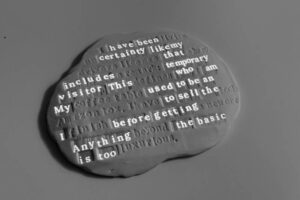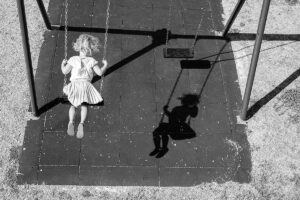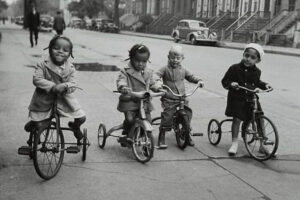![]()
Geneva Navarro has been old longer than I have been alive.
She is in the New Mexico living room of her daughter, Jan, who is meticulously and carefully dressing her in just the very finest: leather regalia that is suitable for high occasion or, in this case, totally strange strangers. She is now 98 years old and the last remaining first language speaker of Comanche on the planet Earth; I’m here working on a project making conceptual portraits of endangered language speakers, learners and revitalizers in decussating paths all over the country, paired with and inspired by poetic words in those languages. After being directed hence by the head of the Comanche language program in Oklahoma, Jan and I have been chatting for weeks, planning out a visual idea that suits the language, fits her mother. I make a point to almost never give instructions on attire but, well, a sitting for a portrait, something that’ll be on the wall in a museum? Folks like to embroider themselves a bit. And as for the image itself – well, within the limits of a nonagenarian on hospice care, we’ve done the best we can: we’ve pored over dictionaries, we’ve chatted extensively. We’ll make the portrait in the room she lives in, sleeps in, is dying in; it’s full of a life’s collection of art and family photographs. And of course we’ll zhuzh it up a bit, too: there’s a word, there’s a concept.
…And there’s fold-out beds. And there’s oxygen tanks. And there’s poor Geneva, after nearly a hundred runs around the sun, being stuffed into firm leather, saying the same thing again, and again, and again: naibikweyainʉʉ.
After she says it five times or ten, I ask her daughter what she keeps saying. Jan laughs: “Oh,” she tells me, “it means I am tired of being beautiful.”
And like that, it changes: weeks of planning, conversations, all fly out the window. There’s a saying in theater that you can’t be stingy on the props: when a fake coin and a real coin hit the stage, everybody can hear the difference. And there, watching Geneva grunt her way into the past, a real coin has hit the stage.
Whatever the concept was before, it has now ceased to exist; the real poem has arrived. Now, please understand: tired of it or not, sitting there —her walls adorned with art, her body adorned with art— she is in fact beautiful, her face a map of the world. And it’s not only this world, but others – one that is vanishing, and one that is slowly appearing again.
Geneva was born into a nation that demands a certain, specific kind of beauty, especially from people like her: she entered life just two years before Edward Curtis, desperate for cash, sold the rights to his lifelong work forging lasting and often imaginary expectations of Native Americans to J. P. Morgan, Junior. The concluding volume of The North American Indian was published in 1930; in total, about 280 sets were sold of his now-completed magnum opus. There is nary a bookstore in this country that you can not walk into this very second to pull a reproduction of it off the shelf.
We do love a trope.
When Francis Ford Coppola’s The Godfather came out in 1972, it changed Italian-American culture forever: suddenly, Americans of Italian descent were adopting slang that did not previously exist, taking on traditions that were entirely fabricated; within only a few years, everybody would swear that these had been habits since time began. So goes it, it seems, for every group: we become the fables and eidola that have been made for us, and even begin to forge new ones. And it becomes for storytellers –writers, image-makers, and, yes, photographers– a perceived necessity. We become addicted to our myths, as lensmen and authors strive through stereotype to craft terminally serious work of devastating self-importance, so heavy with its own virtue that it just might topple over, determined at the cost of reality to make everyone a gangster, a queen, a cowboy, a chief.
![]()
![]()
![]()
![]()
In making On the National Language, I set out to make a project not about ethnicity but about language; an endangered language speaker myself, I didn’t really care much what people look like or where they came from so long as they’re interested in the poetry of the words themselves, the beauty of these many tongues. Of course, in America that cadre runs overwhelmingly Native, though there are lots of people grappling to save African-American and European diaspora languages from the brink of silence. So, at the beginning, I tried to do things the “right” way: I’d reach out to cultural associations, nations, tribes and ask them to recommend to me someone who would be interested in participating in this exhibition, in this book.
Without exception, in the onset, I’d be sent to somebody who couldn’t speak one single word of the language, had no intention to try, but desperately loved to get their picture taken. And the picture they wanted taken? Headdresses and regalia. Ethnic apparel galore. Everybody’s Sunday finest on a Tuesday morning. Stoic poses of vague heroism. These were people who were not tired of being beautiful.
But behind them, more quietly, were the folks doing the work, saving their languages from the larcenous, omnivorous English tongue. It isn’t often pretty; it isn’t always fun. Scorsese doesn’t end his movies with classrooms full of kids learning page after page of verb conjugations. But it’s important, and it’s daunting: there are, approximately, 3,000 endangered languages on the planet today – and these folks are following in footprints that are small (Geneva’s) and gigantic (Geneva’s) to bring these languages from the past through now – recording elders, scanning dusty tomes, making websites, putting together dictionaries. And making photographs. And paintings. And music. And books. And poems.
![]()
![]()
![]()
It is hard not to love the carriers of languages. If sometimes, like Geneva, they carry on their faces maps of the world, they also occasionally carry in their hands actual maps. Take, for example, Matteo Bartoli. In 1897 Bartoli, a Vienna-educated linguistics professor, rushed to the Croatian village of Krk to meet Tuone Udaina, a gruff and unremarkable marine postman who Bartoli had just discovered to be the last living speaker of the Dalmatian language. Udaina hadn’t uttered a word of Dalmatian in twenty years, but had grown up hearing his parents’ private conversations and remembered it well enough to speak in and of it. Bartoli wrote down what he could but, due to the technological limitations of the time, recorded nothing. A few months later Udaina was blown up in an accidental road work explosion and, in an instant, the Dalmatian language vanished into mist right along with him, dashed from the world forever.
The death of languages – a perfectly common occurrence in human history – always comes down to just one person. The survival of them, however, often does as well.
For four hundred years, the fate of language on the American continent has died and lived alike against unspeakable odds: colonial forces, plague, technology and time have worked against all the words that wended their way down a long path from a million different places, and people, to now. Some of them were sown here underneath the very first human footfalls millennia ago; others came later, cramped into boats, pitched into wagons. Plenty have fallen back into the earth but a precious, imperiled, beautiful few survive in the descending transcendence of a language tucked away in corners, hidden under blankets, rolled up in tongues through five centuries of constant invasion. They hold to their credit a few people and a few more words. These, both, are poems and prayers, memories that survive inquisition.
Keats was right, those many years ago: the poetry of the earth is never dead. And so it is fitting that the people who walk it, made from soil, destined to soil again, have found so many ways to make poems of their mouths and minds. Still, there is a bitter reality that all the crops know: winters can come. Winters can be long and hard, and freeze the soil. Some of these languages have a solitary speaker left, they themselves with nobody to talk to in the words of their mothers and grandmothers before them. When they die, it will be an apocalypse of one.
And so, if you’ll forgive the hyperbole: the language revitalizers are fighting against apocalypse.
And I wanted to meet these people. And I wanted the world to meet these people. I’ve hoped that On the National Language might offer the sizzle that sells the steak of so many language revitalization projects around the country. The sequel to Children of Grass (about notable American poets, also featured here on PetaPixel), I wanted to create museum-wall-ready images that show off some of the beauty, some of the poesy of all these languages that we, all connected, might lose in their absence; our very big world is made of lace, all sewn with thread of our many colors looped together. I created it mostly by meeting young language learners and speakers taking up the past with heart, turning it into the future with brio; generally but not exclusively speaking, they’d come up with a few words that might be interesting for showing off the poetry of their language, I’d suggest a few visual concepts that I thought might be fun to do, and then hopefully it’d all work out at the right place and the right moment.
It took me on a circumforaneous route around the nation, an incredible place in a turbulent time: it’s easy to love the America of fireworks and bunting and other accouterments of patriotism. It is harder to adore the adulterous nation and its many messy affairs; this is the nation whose boarding school system nearly single-handedly destroyed several hundred indigenous languages; it’s the same that nearly single-handedly funds their revival, as well.
![]()
![]()
![]()
The hardest part was making folks understand that I had no interest in either anthropology or central casting: that I was not here to be a latter-day fabulist, a 22nd century Edward Curtis – and that they didn’t need to be, either. So often – and it needn’t be so, perhaps mustn’t be so – the people photographers make stories about feel an obligation to be the sort of people photographers yearn to make pictures of, the sort that tourists buy picture postcards of in tourist shops in Arizona and Lancaster County.
Only slightly harder was getting there: endangered languages, by definition, thrive in isolation, and so invariably the address always seemed to be the same: fly eight hours, drive eight hours, go up a long dirt road. I was offered and ate many, many unidentified foods pulled right out of the land; I was invited and declined to go hunt bears for dinner. I was asked to places I’d never heard of and turned away from ones in my own backyard; the elderly woman in New York – one of the last speakers of her ebbing European language – who told me why bother saving the language? I’m the last one left. I have no one to talk to.
Or the Amish man kept me busy most of a week milking his cows and fending off his unmarried daughter before he’d trust me to make the carefully calibrated portrait of him that would satisfy the thesis but not offend God. The only guy who can speak Eyak, an Alaskan tribal language? He’s in France.
It got to be comical, as a wide variety of referring friends and relatives in networks of propinquity who would tell me how to get a hold of these language speakers to try and put something together; by the end of it I half-expected people to tell me “Oh, you wanna talk to Mary? No problem. She has no phone. She’s just sitting on top of a mountain waiting for signals. But she’s available by bonfire after 2.”
But then you go; you make the journey. You try to avoid the tropes. You find the person, you dine on words.
And the languages?
Well. In the end, nobody ever tires of anything being beautiful.
B.A. Van Sise’s On the National Language was released as a book on September 28th and opened as an exhibition at the Skirball Cultural Center in Los Angeles on October 17th.
About the author: B.A. Van Sise is an author and photographic artist with three monographs: the visual poetry anthology Children of Grass with Mary-Louise Parker, Invited to Life with Neil Gaiman and Mayim Bialik, and On the National Language with many others. In photography he has been a finalist for the Meitar Award for Excellence in Photography, and is a Phillip and Edith Leonian Foundation grant recipient, a two time Prix de la Photographie Paris award-winner, a New York State Council on the Arts/New York Foundation for the Arts Fellow in Photography, and a winner of the International Academy of Digital Arts and Sciences’ Anthem Award for Diversity, Equity, and Inclusion. For nonfiction he has been a finalist for the Travel Media Awards for feature writing and is a winner of the Lascaux Prize for Nonfiction, and for poetry he has been a finalist for the Rattle Poetry Prize and Kenyon Poetry Prize, and a winner of the Colonel Darron L. Wright Memorial Writing Awards and the Independent Book Publishers Awards gold medal, twice.









 English (US) ·
English (US) ·